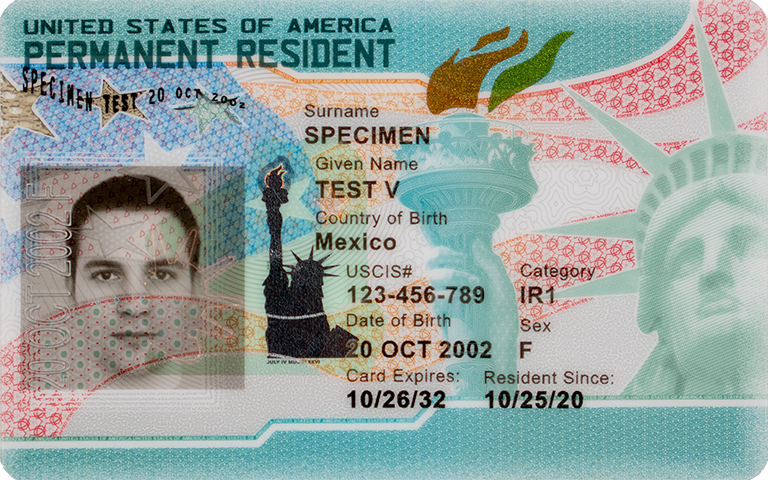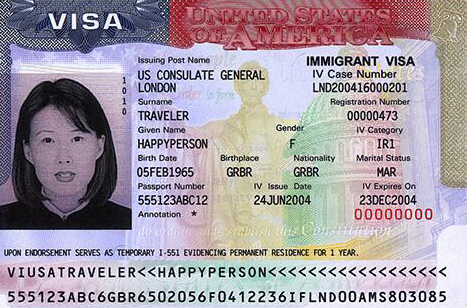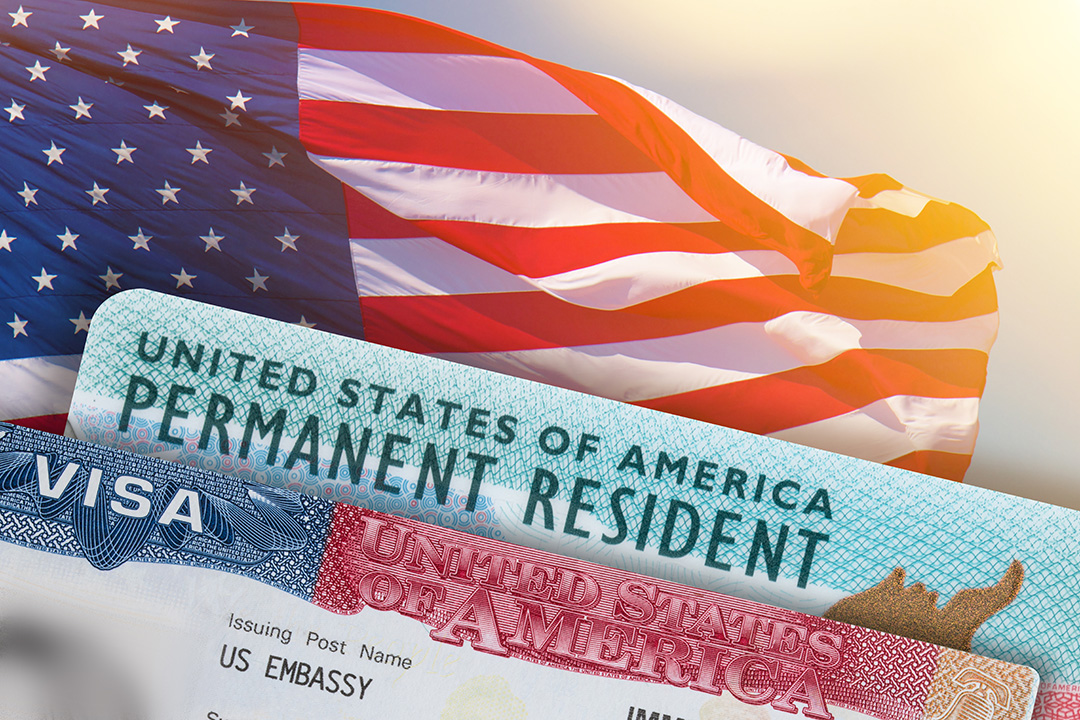The United States has long been a land of opportunity, attracting people from around the world who are seeking a better life, education, or career opportunities. Navigating the U.S. immigration system can be a complex and daunting task, especially when it comes to understanding the various types of legal statuses and permissions granted to foreign nationals. Two of the most commonly discussed immigration terms in this context are “Green Card” and “Visa.” While they may seem similar, they serve different purposes and offer distinct rights and privileges to their holders.

In this article, we will explore the key differences between a Green Card and Visa, providing an overview of their respective purposes, types, benefits, limitations, and application processes. By understanding these distinctions, you will be better equipped to make informed decisions about your immigration journey and choose the path that best aligns with your personal goals and needs.
Overview of Green Card
A Green Card, formally known as a Permanent Resident Card, is a document issued by the United States Citizenship and Immigration Services (USCIS) that grants foreign nationals the right to live and work in the United States permanently. As a Green Card holder, an individual is considered a lawful permanent resident, which offers various benefits and privileges that are not available to temporary visa holders.

Types of Green Cards
There are several pathways to obtaining a Green Card, each with its own set of eligibility requirements and application procedures. The most common types of Green Cards include:
- Family-Based Green Card: This category is for individuals who have close relatives who are U.S. citizens or permanent residents. Family-based Green Cards can be obtained through marriage (marriage Green Cards), parent-child relationships, or sibling relationships, depending on the applicant’s circumstances and the sponsoring relative’s status.
- Employment-Based Green Card: This category is for individuals who possess unique skills, expertise, or qualifications that are in high demand in the United States. There are five preference categories (EB-1 to EB-5) for employment-based Green Cards, which cover various professions and investment opportunities.
- Diversity Visa Lottery Green Card: The Diversity Visa Lottery program offers 50,000 Green Cards each year to individuals from countries with historically low immigration rates to the United States. Applicants must meet certain education or work experience requirements and are selected through a random drawing.
- Special Immigrant Green Card: This category is for certain individuals who may not fit into the other categories, such as religious workers, international broadcasters, or Iraqi and Afghan nationals who have assisted the U.S. government in various capacities.
Benefits of Having a Green Card
Green Card holders of the United States enjoy several benefits, including:
- Permanent Residency: Green Card holders have the right to live in the United States indefinitely, as long as they maintain their lawful permanent resident status and do not commit any actions that could lead to deportation.
- Right to Work: Green Card holders can work in the United States without needing additional work authorization or an employer sponsorship. They can also start their own businesses or change jobs without affecting their immigration status.
- Access to Government Benefits: Green Card holders may be eligible for certain federal and state benefits, such as Social Security, Medicare, and unemployment benefits, depending on their work history and the duration of their residency in the United States.
- Path to Citizenship: After a certain period of continuous residency in the United States, Green Card holders can apply for U.S. citizenship through the naturalization process. This allows them to fully participate in the civic life of the country, including the right to vote in federal elections and hold a U.S. passport.
Overview of Visa
A visa is an official document or endorsement, typically issued by the U.S. Department of State, that grants foreign nationals permission to enter and temporarily stay in the United States for a specific purpose and duration. Visas are generally classified into two main categories: non-immigrant visas and immigrant visas. Each visa type has its own eligibility criteria, application procedures, and restrictions.

Types of Visas
Non-immigrant Visas:
These visas are issued to individuals who wish to enter the United States on a temporary basis for various purposes, such as tourism, business, study, or temporary work. Some common non-immigrant visas include:
- Tourist Visas (B-1/B-2): These visas allow visitors to enter the United States for leisure, medical treatment, or short-term business activities, typically for a duration of up to six months.
- Student Visas (F-1/M-1): These visas are granted to individuals who wish to pursue academic or vocational studies at U.S. institutions. The duration of these visas is generally tied to the length of the academic program.
- Temporary Worker Visas (H-1B/H-2A/H-2B): These visas allow skilled and unskilled workers to enter the United States for temporary employment, often in specific industries or occupations, such as technology, agriculture, or seasonal work.
- Exchange Visitor Visas (J-1): These visas are for individuals participating in cultural exchange programs, such as internships, research, teaching, or au pair opportunities.
Immigrant Visas:
Immigrant visas are for individuals who intend to live and work in the United States permanently. These visas typically lead to the issuance of a Green Card upon arrival in the United States. The most common immigrant visas include:
- Family-Sponsored Visas (IR/CR/F): These visas are for immediate relatives of U.S. citizens or more distant relatives under the family preference system. The number of family-sponsored visas issued each year is subject to certain numerical limits, with some exceptions for immediate relatives.
- Employment-Based Visas (EB): These visas are for individuals who possess unique skills, expertise, or qualifications that are in high demand in the United States. Similar to the employment-based Green Card categories, there are five preference categories (EB-1 to EB-5) that cover various professions and investment opportunities.
Limitations of a Visa
Visas come with certain restrictions and limitations, such as:
- Temporary Stay: Visas grant permission for a limited duration, which varies depending on the type of visa. Once the visa expires, the holder must leave the United States or apply for an extension, change of status, or adjustment of status to remain in the country legally.
- Restricted Work Permissions: Most non-immigrant visas have specific work restrictions or require additional authorization before the visa holder can engage in employment in the United States. For example, tourist visa holders are not allowed to work, while student visa holders may only work under certain conditions and with proper authorization.
- Limited Access to Government Benefits: Temporary visa holders generally do not have access to federal and state benefits, such as Social Security, Medicare, and unemployment benefits. Some exceptions may apply for specific visa categories, but these benefits are generally reserved for permanent residents and U.S. citizens.
Key Differences between Green Card and Visa
While both Green Cards and Visas grant foreign nationals the right to enter and reside in the United States, there are several important differences between the two in terms of duration, work permissions, access to government benefits, and the path to citizenship. Understanding these differences is crucial for determining which option is most suitable for an individual’s needs and goals.
Duration of Stay
- Green Card: Green Card holders have the right to live in the United States indefinitely, as long as they maintain their lawful permanent resident status and do not commit any actions that could lead to deportation.
- Visa: Visa holders are granted temporary permission to stay in the United States for a specific duration, which varies depending on the type of visa. Once the visa expires, the holder must leave the United States or apply for an extension, change of status, or adjustment of status to remain in the country legally.
Work Permissions
- Green Card: Green Card holders have the right to work in the United States without needing additional work authorization or employer sponsorship. They can also start their own businesses or change jobs without affecting their immigration status.
- Visa: Work permissions for visa holders depend on the specific type of visa. Some visas, like the H-1B, allow the holder to work, while others, like the B-2 tourist visa, do not permit employment. In some cases, additional authorization is required before a visa holder can engage in employment.
Access to Government Benefits
- Green Card: Green Card holders may be eligible for certain federal and state benefits, such as Social Security, Medicare, and unemployment benefits, depending on their work history and the duration of their residency in the United States.
- Visa: Temporary visa holders generally do not have access to federal and state benefits. Some exceptions may apply for specific visa categories, but these benefits are generally reserved for permanent residents and U.S. citizens.
Path to Citizenship
- Green Card: Green Card holders can apply for U.S. citizenship through the naturalization process after a certain period of continuous residency in the United States. This allows them to fully participate in the civic life of the country, including the right to vote in federal elections and hold a U.S. passport.
- Visa: Temporary visa holders do not have a direct path to U.S. citizenship. However, some visa holders may eventually adjust their status to that of a permanent resident by obtaining a Green Card, which would then allow them to pursue citizenship through naturalization.
Application Process and Eligibility
- Green Card: The application process for a Green Card typically involves determining eligibility, filing necessary forms, completing required interviews and medical exams, and awaiting approval and issuance.
- Visa: The visa application process involves determining the appropriate visa type, filing necessary forms, scheduling and attending visa interviews, and awaiting approval and issuance. Eligibility requirements and application procedures vary depending on the specific type of visa.
Application Process for Green Card and Visa
Both Green Cards and visas have specific application processes and eligibility requirements. Understanding the procedures for each can help applicants better navigate the immigration system and improve their chances of success.
Green Card Application Process
- Determining Eligibility: Before applying for a Green Card, applicants must determine which category they qualify for, such as family-based, employment-based, or diversity visa lottery. Each category has its own set of eligibility requirements.
- Filing necessary Forms: Applicants must submit the appropriate forms for their Green Card category, such as Form I-130 for family-based applicants or Form I-140 for employment-based applicants. In some cases, applicants may also need to file Form I-485, Application to Register Permanent Residence or Adjust Status.
- Completing Required Interviews and Medical Exams: Applicants may be required to attend an interview with a U.S. consular officer or USCIS official, as well as complete a medical examination by a designated civil surgeon to ensure they meet health-related requirements.
- Awaiting Approval and Issuance: The processing time for Green Card applications can vary depending on the category and the applicant’s individual circumstances. Once the application is approved, the applicant will receive their Green Card or, if they are outside the United States, an immigrant visa to enter the country as a permanent resident.
Visa Application Process
- Determining the appropriate visa type: Applicants must first determine which type of visa is most suitable for their purpose of travel, such as a tourist visa, student visa, or temporary worker visa.
- Filing Necessary Forms: Applicants must submit the appropriate forms for their visa type, such as Form DS-160, Online Nonimmigrant Visa Application, for most non-immigrant visas or Form DS-260, Immigrant Visa and Alien Registration Application, for immigrant visas.
- Scheduling and Attending Visa Interviews: Visa applicants are typically required to attend an interview at a U.S. embassy or consulate in their home country. Prior to the interview, applicants may need to pay the required visa application fee and gather necessary supporting documentation.
- Awaiting Approval and Issuance: The processing time for visa applications can vary depending on the type of visa and the applicant’s individual circumstances. Once the application is approved, the applicant will receive their visa, which will be placed in their passport and used for entry into the United States.
While the application processes for Green Cards and visas share some similarities, it is important to remember that each has its own specific requirements and procedures. Applicants are encouraged to seek professional advice or consult official government immigration resources to ensure they understand and follow the correct steps for their chosen immigration path.
In Summary
Understanding the key differences between Green Cards and visas is essential for anyone considering immigration to the United States. While both offer foreign nationals the opportunity to live and work in the country, their respective durations, work permissions, access to government benefits, and paths to citizenship vary significantly.
A Green Card grants permanent residency, allowing the holder to live and work in the United States indefinitely, access certain government benefits, and eventually apply for citizenship. In contrast, a visa is a temporary document that grants entry for a specific purpose and duration, with varying work permissions and limited access to benefits.
The application processes for both Green Cards and visas require applicants to determine their eligibility, file appropriate forms, attend interviews, and complete medical examinations where necessary. By familiarizing themselves with these processes and seeking professional advice when needed, applicants can improve their chances of successfully navigating the U.S. immigration system and achieving their desired goals.
If you’re in need of personalized guidance and expert advice on your immigration journey, consider reaching out to a Green Card lawyer in Atlanta. At Glenn Immigration LLC, our experienced immigration attorney Pepper Glenn is dedicated to helping you navigate the complexities of the U.S. immigration system. Whether you’re applying for a Green Card, visa, or facing other immigration challenges, our lawyer is here to assist and support you every step of the way. Don’t hesitate to contact us today for a consultation and let Glenn Immigration be your trusted partner in achieving your American dream.
Green Cards and Visa FAQs
In this section, we address some of the most frequently asked questions about Green Cards and Visas. Our goal is to help you better understand these crucial immigration topics, whether you’re curious about eligibility, application processes, or the differences between various visa types.
What is the main difference between a Green Card and a visa?
A Green Card, or Permanent Resident Card, allows a foreign national to live and work in the United States indefinitely as a lawful permanent resident. A visa is a temporary document that grants a foreign national permission to enter and stay in the United States for a specific purpose and duration, such as tourism, study, or work.
Can a visa holder apply for a Green Card?
Yes, some visa holders may be eligible to apply for a Green Card, depending on their individual circumstances and the type of visa they hold. For example, an H-1B visa holder may be sponsored by their employer for an employment-based Green Card. In such cases, the visa holder would need to go through the proper application process, including filing the necessary forms and meeting eligibility requirements.
Can I change my visa type while in the United States?
Yes, it is possible to change your visa type or status while in the United States by filing Form I-539, Application to Extend/Change Nonimmigrant Status, with USCIS. However, you must meet the eligibility criteria for the new visa type, and the change of status must be approved before your current visa expires. Note that some visa types, such as the J-1 exchange visitor visa with a two-year home residency requirement, have restrictions on changing status.
How long can I stay in the United States on a tourist visa?
A tourist visa (B-1/B-2) typically allows the holder to stay in the United States for up to six months. The exact duration of stay will be determined by the U.S. Customs and Border Protection officer upon entry to the country and will be indicated on the traveler’s I-94 Arrival/Departure Record.
Can I work in the United States with a tourist visa?
No, a tourist visa (B-2) does not permit employment in the United States. Working while on a tourist visa is a violation of immigration law and may lead to visa revocation, deportation, or being barred from future entry to the United States.
Can a student visa holder work in the United States?
F-1 student visa holders may work on-campus for up to 20 hours per week during the academic term and full-time during breaks. Off-campus employment is allowed under certain circumstances, such as Curricular Practical Training (CPT) or Optional Practical Training (OPT), with proper authorization from the school’s Designated School Official (DSO) and the United States Citizenship and Immigration Services (USCIS). M-1 vocational student visa holders are only allowed to work through authorized practical training related to their field of study after completing their program.
Can I visit the United States without a visa?
Some foreign nationals from specific countries can visit the United States without a visa under the Visa Waiver Program (VWP). To be eligible, travelers must be citizens of a VWP-participating country, possess a valid electronic passport, and plan to visit the United States for tourism or business for 90 days or less. Additionally, travelers must have an approved Electronic System for Travel Authorization (ESTA) before boarding a U.S.-bound flight.
Is it possible to extend my stay in the United States on a non-immigrant visa?
Yes, some non-immigrant visa holders can apply for an extension of stay by filing Form I-539, Application to Extend/Change Nonimmigrant Status, with USCIS before their current visa expires. The approval of an extension is not guaranteed and depends on the specific visa type and individual circumstances. It is essential to file the extension application on time and maintain lawful status while in the United States.
Can I study in the United States on a tourist visa?
Studying in the United States on a tourist visa (B-1/B-2) is generally not allowed, as these visas are intended for short-term visits for tourism or business purposes. To study in the United States, you must obtain an appropriate student visa, such as an F-1 visa for academic studies or an M-1 visa for vocational studies.
How can I check the status of my Green Card or visa application?
You can check the status of your Green Card or visa application online by visiting the USCIS Case Status Online website (for Green Card applications) or the Department of State’s Consular Electronic Application Center website (for visa applications). You will need to provide your application receipt number or case number to access the current status of your application.
What happens if my visa expires while I am in the United States?
If your visa expires while you are in the United States, it is essential to understand the difference between visa validity and authorized period of stay. Visa expiration only affects your ability to enter or re-enter the United States, while the authorized period of stay is determined by the I-94 Arrival/Departure Record issued by U.S. Customs and Border Protection. As long as you maintain your authorized period of stay, you can legally remain in the United States even if your visa expires. However, if you overstay your authorized period, you may face consequences such as being barred from future entry to the United States or having difficulties obtaining future visas.
Do I need a separate visa for my spouse and children?
Yes, each family member planning to travel to the United States must obtain their own visa, even if they are accompanying you on your trip. In some cases, such as H-4 or F-2 visas, spouses and children can obtain dependent visas that are tied to the primary visa holder’s status. The specific requirements and application procedures for dependent visas vary depending on the primary visa type.
Can I apply for a visa or Green Card if I have a criminal record?
Having a criminal record may affect your eligibility for a visa or Green Card, depending on the nature of the crime and the specific immigration category you are applying for. Some crimes may lead to inadmissibility or disqualification from obtaining a visa or Green Card, while others may require a waiver of inadmissibility.
Can I apply for a Green Card if I am in the United States on a non-immigrant visa?
Yes, you may be eligible to apply for a Green Card while in the United States on a non-immigrant visa, depending on your individual circumstances and the specific visa you hold. The process, called Adjustment of Status, typically requires filing Form I-485, Application to Register Permanent Residence or Adjust Status, along with the necessary supporting documentation. Keep in mind that not all non-immigrant visa holders are eligible for Adjustment of Status, and some may need to return to their home country and apply for an immigrant visa through consular processing.
Do I need a visa if I have a Green Card?
If you have a valid Green Card, you do not need a separate visa to enter the United States. The Green Card serves as proof of your lawful permanent resident status and allows you to enter and exit the country. However, you may still need a visa to enter other countries, depending on their specific entry requirements.


